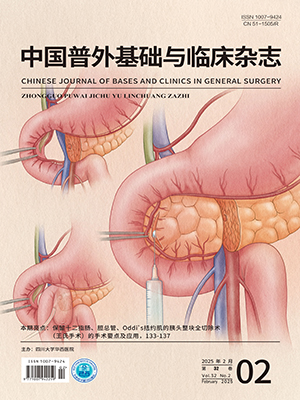| 1. |
Sauerbruch T, Holl J, Sackmann M, et al. Disintegration of a pancreatic duct stone with extracorporeal shock waves in a patient with chronic pancreatitis. Endoscopy, 1987, 19(5): 207-208.
|
| 2. |
Delhaye M, Vandermeeren A, Baize M, et al. Extracorporeal shock-wave lithotripsy of pancreatic calculi. Gastroenterology, 1992, 102(2): 610-620.
|
| 3. |
Matthews K, Correa RJ, Gibbons RP, et al. Extracorporeal shock wave lithotripsy for obstructing pancreatic duct calculi. J Urol, 1997, 158(2): 522-525.
|
| 4. |
Wolf JS Jr, Nakada SY, Aliperti G, et al. Washington University experience with extracorporeal shock-wave lithotripsy of pancreatic duct calculi. Urology, 1995, 46(5): 638-642.
|
| 5. |
Adamek HE, Jakobs R, Buttmann A, et al. Long term follow up of patients with chronic pancreatitis and pancreatic stones treated with extracorporeal shock wave lithotripsy. Gut, 1999, 45(3): 402-405.
|
| 6. |
Bloechle C, Izbicki JR, Knoefel WT, et al. Quality of life in chronic pancreatitis-results after duodenum-preserving resection of the head of the pancreas. Pancreas, 1995, 11(1): 77-85.
|
| 7. |
Johanns W, Jakobeit C, Greiner L, et al. Ultrasound-guided extracorporeal shock wave lithotripsy of pancreatic ductal stones: six years’ experience. Can J Gastroenterol, 1996, 10(7): 471-475.
|
| 8. |
Sauerbruch T, Holl J, Sackmann M, et al. Extracorporeal lithotripsy of pancreatic stones in patients with chronic pancreatitis and pain: a prospective follow up study. Gut, 1992, 33(7): 969-972.
|
| 9. |
Schreiber F, Gurakuqi GC, Trauner M, et al. Ultrasound controlled extracorporeal shockwave lithotripsy of pancreatic calculi in patients with chronic recurrent pancreatitis. Bildgebung, 1994, 61(3): 182-186.
|
| 10. |
Brand B, Kahl M, Sidhu S, et al. Prospective evaluation of morphology, function, and quality of life after extracorporeal shockwave lithotripsy and endoscopic treatment of chronic calcific pancreatitis. Am J Gastroenterol, 2000, 95(12): 3428-3438.
|
| 11. |
Moole H, Jaeger A, Bechtold ML, et al. Success of extracorporeal shock wave lithotripsy in chronic calcific pancreatitis management: a meta-analysis and systematic review. Pancreas, 2016, 45(5): 651-658.
|
| 12. |
van Huijgevoort NCM, Veld JV, Fockens P, et al. Success of extracorporeal shock wave lithotripsy and ERCP in symptomatic pancreatic duct stones: a systematic review and meta-analysis. Endosc Int Open, 2020, 8(8): E1070-E1085.
|
| 13. |
中华胰腺病杂志编委会, 中华医学会消化内镜学分会. 慢性胰腺炎诊治指南 (2012, 上海). 中华消化内镜杂志, 2012, 29(6): 301-303.
|
| 14. |
Zou WB, Ru N, Wu H, et al. Guidelines for the diagnosis and treatment of chronic pancreatitis in China (2018 edition). Hepatobiliary Pancreat Dis Int, 2019, 18(2): 103-109.
|
| 15. |
Ito T, Ishiguro H, Ohara H, et al. Evidence-based clinical practice guidelines for chronic pancreatitis 2015. J Gastroenterol, 2016, 51(2): 85-92.
|
| 16. |
Kim YH, Jang SI, Rhee K, et al. Endoscopic treatment of pancreatic calculi. Clin Endosc, 2014, 47(3): 227-235.
|
| 17. |
Dumonceau JM, Delhaye M, Tringali A, et al. Endoscopic treatment of chronic pancreatitis: European Society of Gastrointestinal Endoscopy (ESGE) Guideline - updated August 2018. Endoscopy, 2019, 51(2): 179-193.
|
| 18. |
Merrill JT, Mullady DK, Early DS, et al. Timing of endoscopy after extracorporeal shock wave lithotripsy for chronic pancreatitis. Pancreas, 2011, 40(7): 1087-1090.
|
| 19. |
Kitano M, Gress TM, Garg PK, et al. International consensus guidelines on interventional endoscopy in chronic pancreatitis. Recommendations from the working group for the international consensus guidelines for chronic pancreatitis in collaboration with the International Association of Pancreatology, the American Pancreatic Association, the Japan Pancreas Society, and European Pancreatic Club. Pancreatology, 2020, 20(6): 1045-1055.
|
| 20. |
de-Madaria E, Abad-González A, Aparicio JR, et al. The Spanish Pancreatic Club’s recommendations for the diagnosis and treatment of chronic pancreatitis: part 2 (treatment). Pancreatology, 2013, 13(1): 18-28.
|
| 21. |
Soytürk M, Bengi G, Oğuz D, et al. Turkish Gastroenterology Association, Pancreas Study Group, Chronic Pancreatitis Committee Consensus Report. Turk J Gastroenterol, 2020, 31(Supp1): S1-S41.
|
| 22. |
Gardner TB, Adler DG, Forsmark CE, et al. ACG clinical guideline: chronic pancreatitis. Am J Gastroenterol, 2020, 115(3): 322-339.
|
| 23. |
Dumonceau JM, Costamagna G, Tringali A, et al. Treatment for painful calcified chronic pancreatitis: extracorporeal shock wave lithotripsy versus endoscopic treatment: a randomised controlled trial. Gut, 2007, 56(4): 545-552.
|
| 24. |
Saghir SM, Mashiana HS, Mohan BP, et al. Efficacy of pancreatoscopy for pancreatic duct stones: a systematic review and meta-analysis. World J Gastroenterol, 2020, 26(34): 5207-5219.
|
| 25. |
Attwell AR, Brauer BC, Chen YK, et al. Endoscopic retrograde cholangiopancreatography with per oral pancreatoscopy for calcific chronic pancreatitis using endoscope and catheter-based pancreatoscopes: a 10-year single-center experience. Pancreas, 2014, 43(2): 268-274.
|




